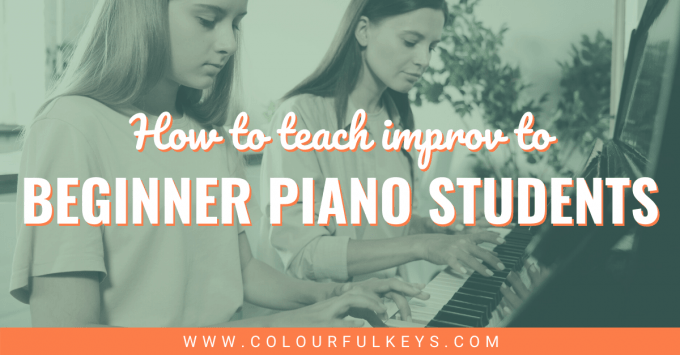Are you in need of some tried-and-tested improv ideas which work for brand new piano students? I’ve got three great go-tos to share with you in this article.

Improvisation is one of the best things you can do with a new student to give them confidence in their own musicality and the freedom to explore the keys.
Any piano improvisation for beginners needs to be simple for 2 reasons:
- They’ll sound fantastic no matter what they play.
- You can really listen to what they’re playing because you’re not distracted with playing some fancy accompaniment.
Try these 3 simple piano improvisation ideas with all your beginners and you’ll be creativity converts in no time.
If I’m preaching to the choir and you want more advanced ways of using improvisation in piano lessons, there are loads of tips and tools on my Creative Skills hub page!
Piano Improvisation Idea #1: Black Key 4 x 4
I call this one “4 x 4” because it consists of 4 chords played with a steady 4 beats in a bar.
Duet Version
Play this pattern with crotchet (quarter note) chords in your right hand and semibreve (whole note) root notes in your left hand:
- G flat major
- D flat major
- E flat minor
- C flat major
Repeat this several times and then hold the G flat major chord to finish.
While you play this accompaniment, your student can create their own music on the black keys.
Here’s a loose example of how this might come together:

Solo Version
Once your student is comfortable doing this kind of piano improvisation duet with you, they might like to try going solo so they can continue to create at home.
I recommend developing the solo version of the 4 x 4 improv in these stages:
- Hold down the pedal and play freely on the black keys.
- Left hand plays a low G flat and the right hand answers it with a short phrase on the black keys.
- Left hand plays G flat for 4 beats and then E flat for 4 beats and repeats. Right hand answers each note with a short phrase on the black keys.
You should always give your student some parameters for their improvisation so that they feel safe to create. But don’t worry if it’s initially very free-form with little sense of metre. A consistent pulse takes time and skill to develop.
Piano Improvisation Idea #2: Happy-Sad-Happy
In this beginner piano improv, we simply switch between major and minor keys to add some flavour and spice while our beginner student creates on the white keys. (Yes, I realise calling major “happy” and minor “sad” is a bit reductive. But just go with it for the purposes of this exercise!)
Duet Version
You can basically do any vamping you like in C major and A minor here and switch between the two while your student plays on the white keys.
If you’re not comfortable winging it and prefer a specific plan, here’s a pattern you could follow:

Solo Version
To create a solo version of the Happy-Sad-Happy improvisation, your student can alternate between C and A in the left hand while their right hand improvises on the C major pentascale.
The magic here is that we need so little to change the flavour of the music. If they do want to add a little more, though, you can certainly show them how to play open fifths, thirds or chords on C and A.
Piano Improvisation Idea #3: E flat Blues
The blues is a classic beginner piano improvisation option.
Too often, though, teachers will go for C blues which is not at all the easiest place to start. I much prefer to begin with the E flat minor blues scale, as this pattern is much quicker to navigate (just the black keys and A natural).
Duet Version
There are so many things you can do with the blues! You could do a full 12 bar blues pattern or experiment with fun patterns in various styles. For starters, though, here’s an easy-peasy accompaniment:

Solo Version
The left hand of the teacher accompaniment above is a great one for students to use if you’re teaching solo piano improvisation. I suggest, however, giving them semibreves (whole notes) to start with so they don’t find the coordination as frustrating.
What are your favourite simple improv ideas for piano students?
Do you have a standard option you love to use with beginner students? Share with the community in the comments below or in the Vibrant Music Studio Teachers Group on Facebook. ❤️